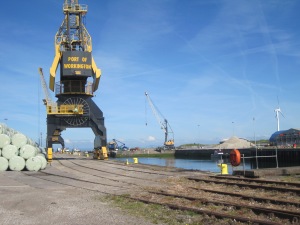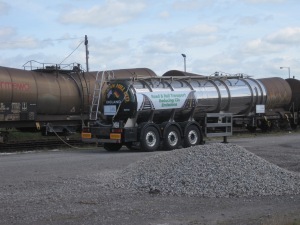Once upon a time you could – it was said – walk from one side of the Prince of Wales dock to the other across the decks of ships, and the Port of Workington employed 150 people. Now, there are about 250 cargo ships a year and about 20 full-time workers.
Once upon a time, not so very long ago, West Cumbria was a hubbub of industrial activity – coal-mines, iron foundries, and chemicals – but all this has gone, and so have the ships carrying the related products.
So it is important that the Port is being reinvented as a ‘multi-modal logistics hub‘: there is the railway, the road, and of course, the sea, and goods can be transported via the Port using any combination of the three.
Now, instead of the two Nelcon cranes lifting the 36-metre railway lines from Corus onto waiting ships, they find new uses in ‘hooking and grabbing’ heavy goods. Now, the grey, rust-stained tanks that once stored phosphoric acid for Albright & Wilson, are used by Cumbrian Storage for recycling of domestic oils: road tankers collect domestic waste oil, which is piped into the storage tanks, then offloaded into ships to be taken to Denmark or Germany.
There is a to-ing and fro-ing, materials entering, and waiting, and leaving.

Kirkby Thore gypsum plant, photographed from the air by Simon Ledingham (from his Geograph collection, http://s0.geograph.org.uk/photos/07/33/073344_2c703e0f.jpg
The grey mountain of gypsum that glitters on the dockside came in by sea, and will be scooped onto road vehicles and delivered to British Gypsum at Kirkby Thore to be used in plaster-board manufacture.
In Thomas Armstrong’s shed, a single man controls the distribution of cement from ship to road-wagon: cement is blown from ship to shed, and shed to wagon, through a pipe.
Behind the shed, a pile of tree-trunks shipped in from the Western Isles waits to be reduced to chippings by a growling machine near the Port’s gate, then carried by road to Iggesund at Flimby.
Iggesund also imports wood pulp for its board-making process. Eucalyptus pulp comes directly from Spain, and from Chile via Flushing in the Netherlands. Iggesund’s share is brought into Workington about once a month, in a small, 3000-tonne, coaster.

From left to right: SRF bales, a Nelcon crane, and the Liebherr crane and the gypsum pile across the dock
A long, high ‘bund’ of cylindrical objects, identically wrapped in pale green plastic – as familiar in appearance as silage bales – almost hides the Harbour-Master’s office from the dock: SRF, Solid Recovered Fuel, the dried and treated product of household waste after recyclates have been removed. There’s an over-supply, so the SRF is brought in by rail from the Mechanical Biological Treatment centre and shipped to Latvia as an alternative fuel.
But the sea is not involved with Iggesund’s calcium carbonate; the Port acts only as a marshalling yard, the calcium carbonate coming in by rail and being transferred to slurry tanks on the dock, then loaded onto road-wagons.
Complex manufactured and engineered objects are dealt with too. The huge new Liebherr crane near the dock-gates can do one-off heavy lifts of ‘project cargo’, such as equipment for E.On’s Robin Rigg windfarm or the nuclear industry. Parts for Sellafield’s Evaporator D were brought in modular form and sent down the coast by sea.
The Liebherr is also waiting for the Port’s transformation into a container traffic hub, when it will come into its own as a ‘lo-lo’ (load on, load off) crane, loading and discharging containers between ships and dockside, and wagons for both road and rail. That will make Workington the only container port between Liverpool and the Clyde, and it will once again have an important place in the scheme of sea-borne goods.
NOTE: (added October 2020). The 2 iconic Nelcon cranes were sold earler in 2020 and removed on barges.
A hydrographic survey was carried out by drone of the harbour and the R Derwent: the video is on YouTube.



